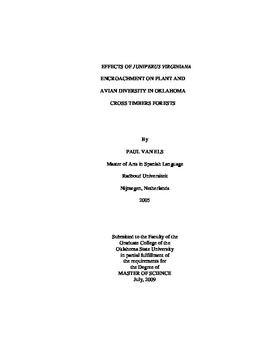| dc.contributor.author | Van Els, Paul | |
| dc.date.accessioned | 2014-04-15T22:00:02Z | |
| dc.date.available | 2014-04-15T22:00:02Z | |
| dc.date.issued | 2009-07-01 | |
| dc.identifier.uri | https://hdl.handle.net/11244/9201 | |
| dc.description.abstract | Scope and Methods: I studied changes in understory vegetation and avian communities due to eastern redcedar (Juniperus virginiana) encroachment into the forest midstory of oak dominated Cross Timbers west of Stillwater in central Oklahoma. I compared vegetation in forest gaps, oak dominated forest without redcedar, at the inner and outer edge of redcedar trees and near redcedar tree trunks (200 plots total). I compared avian communities and avian body condition among six circular-shaped sites, three of which had <10% redcedar cover and three of which had >80%. I also compared communities in 7x9 grid of points in a 30 ha rectangular site. Findings and Conclusions: Species richness (11 to 6 spp. m-2) and cover (53.3 to 12.7%) declined with proximity to redcedar trunks. While these declines were correlated with both increases in litter mass and decreases in photosynthetic photon flux density (PPFD), regression analysis indicated that richness (R?=0.078) and cover (R?=0.177) were best explained by redcedar litter mass. My study indicates that litter is the main determinant of understory vegetation declines associated with midstory encroachment in fire-suppressed forests. Decreases in herbaceous litter loads which historically contributed to the accumulation of fuel beds will have a positive feedback effect for further redcedar encroachment. Declines in oak recruitment that were related to increasing redcedar abundance and consequent increases in litter loads may lead to changes in overstory composition. Body condition was negatively correlated with redcedar canopy cover for my three focal species. Total species richness was negatively correlated with redcedar cover (r?=0.09, P=0.02). Results indicate that food was not limiting to focal species in encroached stands, and some species occurred in higher abundance in these stands. However, the effects of redcedar on birds are species dependent as bark-probing birds such as woodpeckers were negatively correlated with redcedar cover, possibly due to foraging impediments related to redcedar physical structure. | |
| dc.format | application/pdf | |
| dc.language | en_US | |
| dc.publisher | Oklahoma State University | |
| dc.rights | Copyright is held by the author who has granted the Oklahoma State University Library the non-exclusive right to share this material in its institutional repository. Contact Digital Library Services at lib-dls@okstate.edu or 405-744-9161 for the permission policy on the use, reproduction or distribution of this material. | |
| dc.title | Effects of Juniperus virginiana encroachment on plant and avian diversity in Oklahoma cross timbers forests | |
| dc.type | text | |
| osu.filename | vanEls_okstate_0664M_10451.pdf | |
| osu.college | Agricultural Sciences and Natural Resources | |
| osu.accesstype | Open Access | |
| dc.description.department | Department of Natural Resource Ecology and Management | |
| dc.type.genre | Thesis | |
